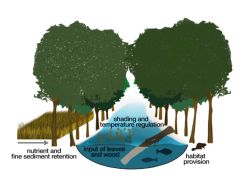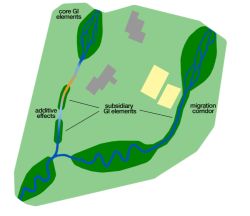Background of OSCAR

Under natural conditions, most rivers in temperate regions would run through forests. The remaining near-natural river reaches with well-developed riparian forests are biodiversity hot-spots that offer multiple functions and ecosystem services.
To a certain degree, woody riparian buffer strips along rivers (referred to as woody buffers in the following) offer similar benefits. Habitat and species diversity are usually high, as well as water quality due to the retention of nutrients, pesticides and fine sediment. Moreover, shading dampens water temperatures and mitigates the effect of climate change. The input of leaves and wood supports riverine food webs.
Besides these local effects in the buffered river segment, down- and upstream river segments may also benefit and effects of woody buffers in individual river segments potentially add up in downstream direction and they may provide migration corridors connecting near-natural sites in a green infrastructure network.
While the principal mechanisms how woody buffers enhance biodiversity and certain ecosystem functions are well understood (e.g. Sweeney and Newbold 2014), there is still a high uncertainty associated with quantifying these general effects. Moreover, most studies deal with the effects of individual woody buffers at the river segment scale and there is very limited knowledge on how these effects depend on the spatial arrangement and add up at the river network and catchment scale, and their function as migration corridors has hardly been studied as such.

These knowledge gaps limit the strategic and targeted implementation of woody buffers in river basin management, conservation planning, and agro-environmental measures. To live up to its full potential as central elements of green infrastructure, the general effects as well as the spatial arrangement of woody buffers at the catchment scale need to be considered and transferred into knowledge rules, which can easily be applied by planners and water managers.